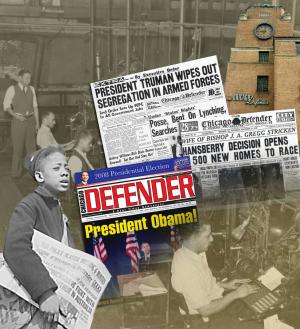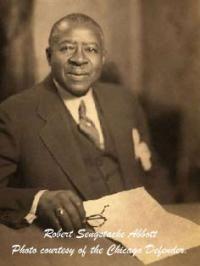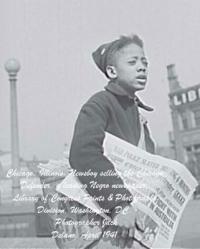
On May 5, 1905, Robert Sengstacke Abbott founded the Chicago Defender newspaper, published in Chicago, Illinois. The Defender began with an introductory investment of 25 cents and a press run of 300 issues, but it grew into the most influential African-American publication in the United States during the early to mid 20th century. Abbott, the son of former slaves, gained success as one of the country's first African-American millionaires.
The Defender assumed a national editorial approach and initiated some of the most crucial racial equity movements in American history, including The Great Migration of black Americans from the South to the North and the integration of U.S. Armed Forces during World War II. In 1929, the Defender sold over 250,000 copies weekly, and at its peak in the 1930s, this newspaper rallied thousands and revolutionized the black press in America with its readership at an all time high of 500,000. Abbott deemed it “The World's Greatest Weekly,” a modified moniker that he shrewdly borrowed from the Chicago Tribune.
From the outset of his foray into publishing, Abbott adopted the motto, “American race prejudice must be destroyed,” which was a conviction derived from his own racial victimization. He knew what it felt like to stand in a breadline and be forced to forfeit his place to a white man, and told to abandon a career in law after graduation from Georgia's Kent School of Law because his dark complexion would not make an impression on the courts. As author Roi Ottley writes in The Lonely Warrior, his 1955 biography of Abbott, “Born on the heels of the Emancipation Proclamation [Abbott] grew up [in Georgia] under a pattern of color – white, mulatto and black – which even as a boy frustrated his aspirations….His resentments were to be translated into the cardinal principles of the newspaper he would establish...” Abbott's mission was to defy color prejudice, and this objective guided every aspect of the Defender's reportage.
In order to attract a national readership Abbott, along with his first full-time employee, J. Hockley Smiley, utilized the sensationalistic journalism commonly associated with newspaper magnates Joseph Pulitzer and William Randolph Hearst. He used banner headlines such as, “100 Negroes Murdered Weekly in United States by White Americans.” He printed these headlines in red ink with graphic images that depicted the battering and lynching of black Americans – especially Southern blacks – in articles appearing alongside fiery editorials that denounced white oppression, encouraged improvement of public conduct, expounded the exigencies of civil rights, and called for the integration of Chicago's fire and police departments.
 In the early 1900s, the majority of African-Americans lived in the former slave-holding states in the South, and although Southern whites viewed the Defender as subversive and prohibited its distribution, many read it throughout the region despite threats made by Ku Klux Klan members to harm its readers. Regardless of the threats of lynching, newsboys sold copies of the paper when Pullman porters and traveling entertainers smuggled it into the South. By late 1910, circulation surpassed 50,000, and Abbott urged his readers to leave the Jim Crow South with its cotton fields for the urban North's factory jobs and less hostile segregation.
In the early 1900s, the majority of African-Americans lived in the former slave-holding states in the South, and although Southern whites viewed the Defender as subversive and prohibited its distribution, many read it throughout the region despite threats made by Ku Klux Klan members to harm its readers. Regardless of the threats of lynching, newsboys sold copies of the paper when Pullman porters and traveling entertainers smuggled it into the South. By late 1910, circulation surpassed 50,000, and Abbott urged his readers to leave the Jim Crow South with its cotton fields for the urban North's factory jobs and less hostile segregation.
According to the Defender's former editorial writer, Metz T.P. Lochard in a 1947 profile of Abbott titled “Race Leader,” Abbott was disturbed by the “vile manifestations of everyday discrimination and hate against [Southern] Negroes” – and this cruelty “twisted [his] heart.” Abbott insisted that the first critical step toward throwing off the shackles of the slave tradition and claiming the freedom that Emancipation intended was for blacks to escape the “exploitive” and “suppressive” South. Subsequently, to spur northward migration, Abbott displayed pictures of Chicago’s finest schools, homes, and parks in the Defender and contrasted them with photos of dilapidated areas in the South. He published one-way train schedules, Northern job postings, and the success stories of those who had already made the move. He emblazoned headlines such as “Good-bye, Dixie Land” across the Defender’s front page, and the paper declared May 15, 1917, as the date of the “Great Northern Drive.”
“Abbott dared to articulate in print what southern Negroes were afraid to whisper,” Lochard writes. “He gave them courage to acknowledge their dissatisfaction, some sense of security that others were championing their cause and could give them protection in the city that was the home of the Defender.”
Ottley corroborates Lochard's assertion. As he writes in The Lonely Warrior, “mass exodus North…was the most ambitious project ever undertaken by the Defender. Consequently, Abbott did everything to aid and abet the migration. He argued, pleaded, shamed, and exhorted Negroes to abandon the South.” He was a “man of incorruptible racial idealism,” yet, “the migration assumed proportions never envisioned by Abbott.” Indeed, nearly 110,000 journeyed to Chicago between 1916 and 1918, virtually tripling the city's black population.
 The Defender's competitors during this era included The Afro-American, established in 1892 in Atlanta by a former slave, John Henry Murphy Sr., which became a regional publication in Baltimore and Washington, DC. Other competitors included The California Eagle, which under the editorial direction of Charlotta A. Bass, decried racism in the motion picture industry, and spearheaded a campaign to oppose D.W. Griffith's film Birth of a Nation. Another competitor, The Pittsburgh Courier, encouraged African-Americans to become participants in the political process. The Chicago Conservator, founded in 1878 by Ferdinand L. Barnett became the Defender's closest regional rival. Later purchased and published by famed anti-lynching crusader Ida B. Wells (who later married Barnett in 1895), the Conservator ranked as Chicago's first black newspaper. Its editorial mission favored community news, local politics, and stories about religion and family life.
The Defender's competitors during this era included The Afro-American, established in 1892 in Atlanta by a former slave, John Henry Murphy Sr., which became a regional publication in Baltimore and Washington, DC. Other competitors included The California Eagle, which under the editorial direction of Charlotta A. Bass, decried racism in the motion picture industry, and spearheaded a campaign to oppose D.W. Griffith's film Birth of a Nation. Another competitor, The Pittsburgh Courier, encouraged African-Americans to become participants in the political process. The Chicago Conservator, founded in 1878 by Ferdinand L. Barnett became the Defender's closest regional rival. Later purchased and published by famed anti-lynching crusader Ida B. Wells (who later married Barnett in 1895), the Conservator ranked as Chicago's first black newspaper. Its editorial mission favored community news, local politics, and stories about religion and family life.
Each of these newspapers championed racial equality, social advancement and gave voice to the marginalized and oppressed, but none had the concentration of readership – expressly, a Southern audience – that the Defender enjoyed, and none was as aggressive and confrontational when it came to publicizing the plight of African-Americans. Readers saw in the pages of the Defender satirical pieces that mocked white establishment, on-the-scene and unvarnished reporting of atrocities committed against black Chicagoans as well as Southern blacks, poems, and opinion columns – all of which illustrated precisely, and for the first time, the struggles and aspirations of their common experience. Abbott gained the trust of his readers by implementing his own particular brand of journalism.
Abbott died of Bright's disease in 1940, and his nephew and heir, John Henry Sengstacke, assumed the roles of editor and owner until his death in 1997. Sengstacke led the Defender in its protest against unequal treatment of black servicemen during World War II and its appeal for the integration of the armed forces. The Defender published articles that chronicled the achievements of black soldiers and exposed the military's discrimination against them. The U.S. government threatened to jail black publishers for sedition because of this public criticism, but Sengstacke persisted and urged President Harry S. Truman to issue an executive order ending segregation in the military.
Sengstacke also served as an adviser to former Presidents Truman, John F. Kennedy, and Lyndon B. Johnson. In addition, in 1956, Sengstacke transformed the newspaper into a daily and renamed it the Chicago Daily Defender.
 The front page of the Chicago Defender newspaper for July 31, 1948, with the lead story announcing that President Harry S. Truman had issued Executive Order 9981 ending racial segregation in the United States Armed Forces. The placement of the story shows the importance that the African-American community attached to Truman’s action. This image appears as part of a Library of Congress educational exhibit.
The front page of the Chicago Defender newspaper for July 31, 1948, with the lead story announcing that President Harry S. Truman had issued Executive Order 9981 ending racial segregation in the United States Armed Forces. The placement of the story shows the importance that the African-American community attached to Truman’s action. This image appears as part of a Library of Congress educational exhibit.
The Defender, celebrated for its quality of writing, and clearly recognized as a force for social action and racial justice, became the home for many acclaimed writers, including W.E.B. DuBois, a founder of the National Association for the Advancement of Colored People; Pulitzer Prize-winning poet Gwendolyn Brooks; novelist Willard Motley; and James Forman, a civil rights activist of the 1960s.
Writer and poet Langston Hughes, regarded as America's Dean of Black Letters, began writing his column for the Defender in 1942. It ran for more than 20 years, and in essays like “The Detroit Blues” (1943) and “Freight” (1947), Hughes illustrated the vexations of racial prejudice in contemporary life. And Ethel Payne, who worked at the Defender for 28 years as feature writer, Washington correspondent, and associate editor, chronicled the South during the civil rights struggle in her noted series, “The South at the Crossroads.” She also covered the Vietnam War in 1966.
By the mid-1990s, the Defender’s circulation dropped to approximately 30,000, and in 2003, Real Times Inc, a company controlled by a relative of Sengstacke bought the paper. Its endorsement of Sen. Barack Obama for president in October 2008, expressed the Defender's abiding view that racial consciousness is an ongoing struggle in American society: “For the Black community, and, we think, the general community, there is only one choice, Sen. Barack Hussein Obama...And yes, race is a factor. An Obama presidency heralds to the world that the United States of America has come a long way, and that will help repair this nation’s standing around the world. The son of a Black Kenyan father and a white Kansan mother, Obama is the herald of this multicultural society.... [Obama] presents the best opportunity for this nation to 'live out the true meaning of its creed.' This historic vote is not just an opportunity to elect a Black man to the highest office of the land, the most powerful office in the world, but it is an opportunity to elect the best man for the job.”
Although the Chicago Defender’s influence has slightly diminished since it first initiated social change and seared the idea of racial equality into the minds of Americans, this 104-year-old powerhouse publication won five prestigious awards for journalism at the National Newspaper Publishers Association Merit Awards Gala in 2009. Receiving these awards illustrates that the Defender maintains its influence in the community that it serves and remains an important outlet of expression for African-Americans throughout the United States.

Comments
Abotts Dream
I'm glad to see equality is progressing, though I hope this doesn't create a "good enough" disposition and lead many to think racism and inequality is "over"